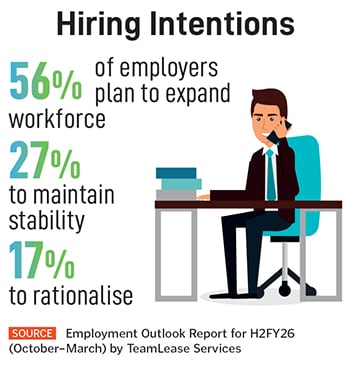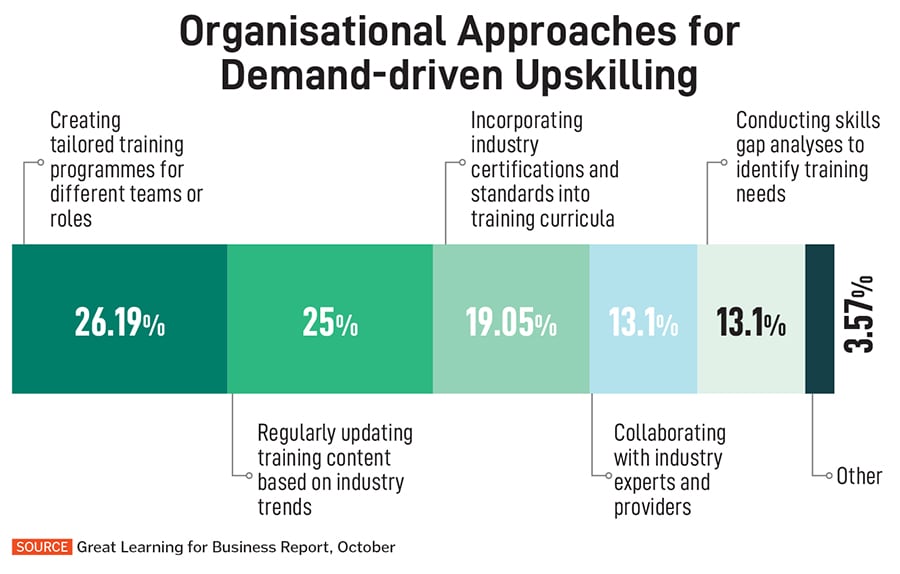As companies redefine performance metrics, and flatten organisational hierarchies, it becomes even more urgent for companies and the middle layer to find a way forward. “It is where the most upskilling needs to happen, as behavioural skills become more critical on the path to senior management. While there is risk, there is also significant opportunity,” says Roopank Chaudhary, partner at Aon, a professional services firm specialising in human capital consulting.
![]()
Middle Management Under Pressure
In the past three months, Accenture has laid off over 11,000 employees, reducing its global headcount to 779,000. Severance costs reached $615 million, with an additional $250 million expected in the current quarter. CEO Julie Sweet acknowledged that the company was “exiting people on a compressed timeline where reskilling is not a viable path”. While Accenture did not publish a precise breakdown by role level, industry analysis and internal commentary suggest that middle management and back-office corporate functions were heavily impacted.
![]()
Shortly after, TCS announced 12,000 layoffs, reflecting similar pressures from generative AI adoption and operational
optimisation. The tech giant stated that layoffs would primarily affect middle and senior management roles. This adds to a larger trend of layoffs in the industry. Google laid off approximately 12,000 employees in January 2023, representing around 6 percent of its workforce, and has since continued to reduce staff in select teams.For middle managers across the country, the message is clear: AI is no longer a futuristic concept; it is reshaping work today. And the challenge for companies is to retain this layer of experienced professionals. Without them, organisations risk losing institutional knowledge, project continuity, and team morale, all vital for long-term growth.
“Middle management is a tricky spot and ends up being not the most invested sector [in terms of skilling programmes and development opportunities],” says Chaudhary of Aon. He adds that this is the sector where upskilling is most essential, “because you still have a long way to go, and you’re on the path to senior management. That’s where behavioural skills start to become more important”.
Also Read: AI is increasing demand for managers - and changing their skill sets
Upskilling, Reskilling
Mid-level leaders, experts point out, must evolve from process controllers to AI interpreters, learning to trust algorithms and focus on strategic orchestration.
“Managers must constantly upgrade skills to understand and apply new technologies while balancing business-as-usual responsibilities,” says Udayan Dutt, president–group HR, RPG Group. “AI automates many operational and analytical tasks, and managers are transitioning from information intermediaries to enablers of human-AI collaboration. Managing distributed and hybrid teams adds another dimension, requiring trust, empathy, and inclusion,” he adds.
![]()
Chaudhary points out that while middle management remains vulnerable to turnover due to salary differentials, companies investing in leadership development, career-pathing, and upskilling can mitigate this risk.
Companies seem to have taken note and are ensuring they not only retain critical talent but also build a resilient workforce that is prepared for future tech disruptions.
RPG Group has embraced a dual-track leadership model, allowing managers to grow as domain experts or people leaders. “What earlier took several follow-ups or manual data consolidation now happens instantly through AI-enabled systems,” Dutt says. “Managers no longer spend time collecting or validating information—they spend it interpreting insights and making faster decisions.”
AI fluency, data science, analytics, cybersecurity, and interpersonal agility have become essential competencies. Programmes like Zensar’s Ignite GenAI Academy, CEAT’s function-specific academies, and KEC’s SAGE enterprise assistant ensure continuous learning. According to Dutt, “Over half the delivery workforce has completed GenAI training, with 350 employees certified at advanced levels and deployed on live projects. At group level, E-Luminati, our Digital Academy, has trained over 2,000 RPGians.”
Tata Technologies, too, has adopted a similar model. Through TechVarsity, employees across levels undertake mandatory AI training, from foundational to advanced courses, complemented by hands-on workshops and shadowing on live projects. “We measure training not just for completion but by deployment into live projects and ROI. For middle management, rigorous, multi-tiered programmes ensure that managers can apply AI skills in practical business contexts... Career progression is now non-linear. Managers are moving into roles like AI Programme Leads or Digital Transformation Catalysts. Flat, cross-functional structures have proven 25–30 percent more efficient in projects with deep AI integration,” says Srinivas.
![]()
RPG and Tata Technologies are not alone in ramping up their training and reskilling opportunities; mid-level training demand has surged across industries. “What we are seeing is that many best-in-class companies are making a disproportionate amount of investment in middle management—in development, leadership training, and building a career path,” says Chaudhary of Aon.
Great Learning for Business, a global edtech firm, reports a 133 percent increase in training demand for mid-level managers in FY25, highlighting a pivot towards equipping employees at the intersection of execution and leadership. Training demand for mid-level employees jumped to 35 percent in FY25, up from 15 percent in FY24, as firms doubled down on equipping managers for a tech-enabled future.
Across sectors, AI and data skills are now essential, with 48 percent of IT/ITeS firms, 14 percent of manufacturing, and 10 percent of BFSI companies prioritising AI training. The focus is on AI, generative AI, data science, analytics, and cybersecurity.
Organisations are also increasingly conducting quarterly skills-gap assessments to ensure learning investments translate into measurable ROI. About 26 percent of organisations are creating tailored programmes for specific teams or roles, ensuring that training aligns with immediate job responsibilities. Another 25 percent regularly update their curriculum to match emerging industry trends, while 19 percent integrate industry certifications and standards to give managers recognised credentials.
The Road Ahead
Management consulting firm Korn Ferry’s Workforce 2025 survey revealed that 41 percent of employees reported reductions in management layers in the past year. The thinning of managerial ranks has left 43 percent of employees feeling that leaders aren’t aligned and 37 percent feeling directionless. However, Lesley Uren of Korn Ferry warns in the report, “A leaner organisation today can mean a leadership crisis tomorrow. When management disappears, so does direction.”
![]()
Senior leaders, meanwhile, are burdened with day-to-day operational responsibilities in addition to strategic oversight, struggling to meet expectations amid rising complexity.
To this end, “As AI and emerging technologies reshape the landscape of work, enterprises are prioritising internal talent development over traditional hiring, focusing on cultivating agile, future-ready workforces across all levels,” says Ritesh Malhotra, enterprise head at Great Learning.
The path forward for middle management is complex but navigable. Leaders must combine technical fluency with human-centric skills. As Dutt puts it, “While technology can accelerate output, leadership rooted in empathy, ethics, and human connection remains irreplaceable.”





